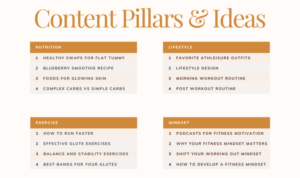Crafting Brand Messaging sets the stage for businesses to make lasting impressions through strategic communication. Dive into the world of brand messaging and discover how it shapes consumer perceptions and drives success.
Crafting Brand Messaging

Crafting brand messaging is crucial for any business looking to establish a strong identity and connect with its target audience. It involves creating a unique voice and personality for the brand that resonates with customers and sets it apart from competitors.
Examples of Successful Brand Messaging Strategies
- Apple: Known for its simplicity and innovation, Apple’s brand messaging emphasizes cutting-edge technology and user-friendly design.
- Nike: Just Do It. This iconic slogan embodies Nike’s brand messaging, inspiring customers to push their limits and achieve greatness.
- Coca-Cola: Open Happiness. Coca-Cola’s brand messaging focuses on spreading joy and positivity through its products.
Key Elements in Crafting Brand Messaging
- Target Audience: Understanding who your customers are and what resonates with them is essential in crafting effective brand messaging.
- Unique Selling Proposition: Highlighting what sets your brand apart from competitors helps create a compelling message that attracts customers.
- Consistency: Maintaining a consistent tone, voice, and visual identity across all communication channels helps reinforce the brand message.
- Emotion: Connecting with customers on an emotional level can create a lasting impact and build brand loyalty.
Understanding Your Target Audience

Understanding your target audience is crucial for effective brand messaging because it allows you to tailor your message to resonate with the specific needs, preferences, and behaviors of your ideal customers. By knowing who your audience is, you can create content that speaks directly to them, ultimately leading to better engagement and conversion rates.
Researching and Analyzing Your Target Audience
Researching and analyzing your target audience can be done through various methods such as surveys, interviews, social media insights, and analyzing website analytics. These methods can provide valuable information about your audience’s demographics, psychographics, buying behavior, and preferences, which can then be used to craft more targeted and relevant brand messaging.
- Conduct surveys and interviews to gather direct feedback from your audience.
- Utilize social media insights to understand the interests and behaviors of your followers.
- Analyze website analytics to track user behavior and preferences on your site.
Creating Buyer Personas
Creating buyer personas is a valuable strategy in crafting brand messaging that resonates with the audience. Buyer personas are fictional representations of your ideal customers based on real data and research. By creating detailed buyer personas, you can better understand the motivations, pain points, and preferences of your target audience, allowing you to tailor your messaging to address their specific needs effectively.
By understanding your target audience and creating detailed buyer personas, you can ensure that your brand messaging is relevant, engaging, and compelling to the people you want to reach.
Consistency Across Platforms
Maintaining consistency in brand messaging across different platforms is crucial to build a strong and recognizable brand identity. When customers encounter the same message, tone, and visuals across various channels, they are more likely to remember and trust the brand.
Examples of Consistent Brand Messaging
- Apple: Apple is known for its consistent messaging of simplicity, innovation, and sleek design across all its products, advertising, and social media platforms.
- Nike: Nike’s messaging of empowerment, athleticism, and perseverance is consistent in its marketing campaigns, sponsorships, and social media presence.
- Coca-Cola: Coca-Cola maintains a consistent brand message of happiness, togetherness, and sharing moments of joy across its global marketing efforts.
Challenges and Solutions for Consistency
- Challenge: Different platforms have unique requirements and limitations, making it challenging to adapt the same message across all channels.
- Solution: Develop a comprehensive brand style guide that Artikels messaging, tone, visuals, and guidelines for each platform to ensure consistency.
- Challenge: Managing multiple teams and agencies working on different platforms can lead to inconsistencies in messaging.
- Solution: Implement regular cross-team meetings, training sessions, and reviews to align everyone on the brand messaging strategy.
- Challenge: Keeping up with evolving trends and customer preferences on each platform can make it difficult to maintain consistent messaging over time.
- Solution: Conduct regular market research, analyze data, and gather feedback to adapt the brand messaging while staying true to the core values and identity of the brand.
Differentiation and Unique Selling Proposition: Crafting Brand Messaging
In the crowded marketplace, standing out from competitors is crucial for a brand’s success. Highlighting a unique selling proposition (USP) in messaging is key to capturing the attention of target audiences and building brand loyalty.
Importance of USP in Messaging
Emphasizing a brand’s unique selling proposition sets it apart from competitors by showcasing what makes it special and different. This helps consumers understand why they should choose a particular brand over others in the market.
- Clearly defining and communicating a USP helps establish a brand’s identity and positioning in the minds of consumers.
- It creates a strong foundation for brand messaging, guiding all communications to be consistent and focused on what makes the brand unique.
- Having a compelling USP can drive brand loyalty, as customers are more likely to remember and connect with a brand that offers something distinct.
Strategies for Differentiating a Brand in Messaging
To differentiate a brand effectively from competitors through messaging, consider the following strategies:
- Focus on the benefits: Highlight how your product or service solves a specific problem or fulfills a need better than others in the market.
- Showcase brand values: Communicate the values and beliefs that set your brand apart and resonate with your target audience.
- Create a memorable brand story: Share the journey, inspiration, or behind-the-scenes stories that make your brand authentic and relatable.
- Use unique language and tone: Develop a distinct voice that reflects the personality of your brand and connects with consumers on a deeper level.
Examples of Brands with Effective USP Messaging
Several brands have successfully communicated their unique selling propositions through compelling messaging:
Apple: “Think Different” – Apple’s focus on innovation, simplicity, and design sets it apart in the tech industry.
Nike: “Just Do It” – Nike’s empowering messaging and emphasis on athleticism have made it a leader in the sportswear market.
Subway: “Eat Fresh” – Subway’s commitment to fresh, customizable sandwiches differentiates it from traditional fast-food chains.





